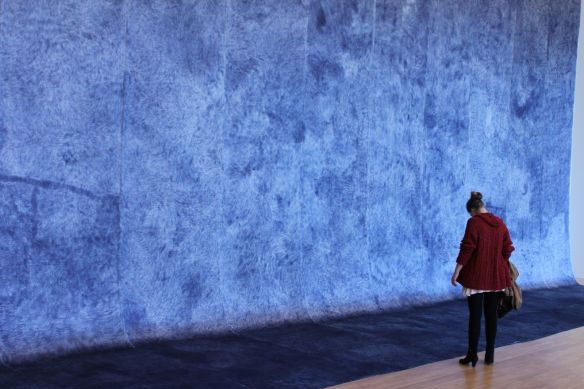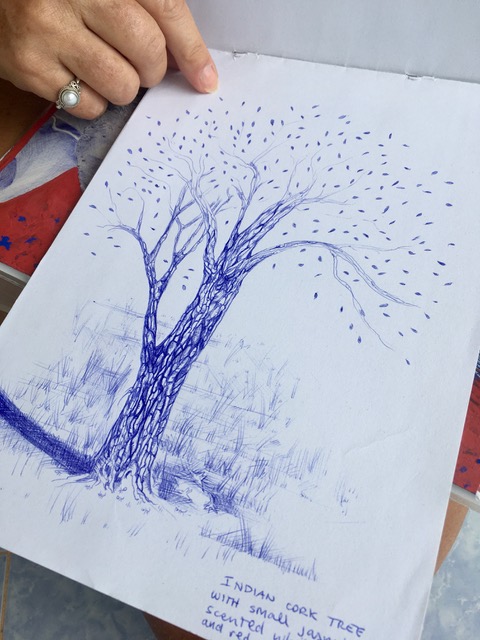
Jan Fabre BIC Art Installation, Belgium. Photo: Clare Ann Matz
by guest author Clare Ann Matz
My first encounter with art created by BIC pen was when I interviewed the Belgium artist Jan Fabre during his first Italian solo show at the Centro Pecci in Prato, Italy in 1994 for the cultural TV program I was hosting on SuperChannel London named „BlueNight“.
The impact and beauty of his installation, completely created by blue ball pen scribbles and insects was overwhelming. Jan explained that he had been inspired by his grandfather, who collected insects. His initial biro drawing efforts appear to have started when he tried to mimic the movement of an insect moving over the page of his sketchbook as a young child.
Decades passed until recently I came across BIC art again. As I was waiting on board of a flight for take off I came across an article about the creation of the BIC contemporary art collection.

Inspired by a Flight Magazine: Clare Ann Matz.
This collection consists of more than 250 pieces by internationally recognized or upcoming artists. The works of art all have a point in common: They have been created with or inspired by BIC products. And having looked into some of the art work I wanted to know more about the tool itself. An amazing instrument which is available to artists around the world at a very, very low price.
Here are some historic facts they impressed me about the BIC pen:

Technical details of the BIC pen. Photo: Clare Ann Matz
The ball-point pen invented by Hungarian newspaper editor Lazlo Biro in 1931 made major improvements over the fountain pens of the time. Biro’s ballpoint pen consisted of three components: The steel outer casing, the ink cartridge, and ball-point tip. Biro noticed that newspaper ink dried much faster than the fountain pen ink and lead to less smudging He worked with chemists to develop a new type of fast-drying ink based on the newspaper ink that could be used with pens.
The problem was that this ink was a high viscosity fluid that made it unusable with fountain pens since it couldn’t flow between the ink cartridge and the tip. To overcome this issue, Biro invented the ball-point tip. The tip consisted of a ball and socket joint and a tiny tube that connected with the ink cartridge. Just like with fountain pens, ink would fall through the tube due to gravity, but this time it would fall on top of the steel ball. Then as the tip of the pen slid along the paper, the ball would roll and distribute the ink that lay on top into the paper (from History of Pens, 2018).

BIC pen art by Clare Ann Matz.
Where the magic flows: The Cupper Ball Holder
The cupper ball holder is a small metallic piece that houses the metal ball. It is made up of a conical shape and a cylindrical shape. The conical shape is hollow on the inside to fit the ball but narrow at the tip so that the ball does not fall out.
As a multimedia artist I decided to give BIC art a try, and started by drawing a few fantasy figures, just to test the technique. I soon discovered that it looks a lot easier than it actually is. Fortunately I found several useful tutorials by Nigerian artists (who are absolutely masters in BIC art) and began to tackle still life and then portraits, and ultimately hyperrealistic portraits.
Now I use several different pens to create different effects, as each pen varies in size, ink flow and ink colour. After sketching the basics with a pencil and checking dimensions I start filling in the shadows, working lighter and lighter as I go on.
Many of the artists I have seen on internet work adding layers (the technique is called „hatching“) from light to dark, but having worked extensively in the past in creating Russian Icons, with traditional egg tempera colour, I learned to go from dark to light, as a spiritual practice of moving out of darkness and into the light. Therefore I have adopted this technique in my BIC art and do my hatching with progressively lighter, wider strokes.
The important thing to remember when creating images with a ball point pen is that the lines cannot be erased. Once down … there forever; in some ways it is similar to tattoos.

„Sandro“ by Clare Ann Matz.
So, as I continue to study the fast paced world of AI (artificial intelligence) creating artwork, music, writing and NFTs (and soon videos), I can now counterbalance this hectic medium with patience (each portrait takes about 2 weeks to create), silent, meditative BIC art.
And get lost in the depths of the shades of my favourite soothing colour, BLUE.
My signature touch is to finalize the portraits with colourful acrylic backgrounds, to bring out the subject’s personality and emotional environment.

Masterwork with BIC pens.

